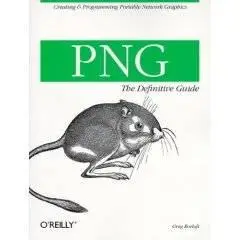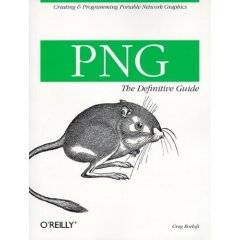PNG: The Definitive Guide (O'Reilly Nutshell) , Author(s): Greg Roelofs | Publisher : O'Reilly | ISBN : 1565925424 | PDF | 1.33 MB | 354 pages | 1999
Part I, Using PNG
Part I is intended for designers, web site owners, casual image creators, and web surfers–anyone
who wants a quick start on using PNG images in a variety of applications. Such users may need
only a brief overview of PNG features, but they want to know what applications support the format
and to what extent, how to invoke PNG-specific features within the applications, and how to work
around certain bugs or incompatibilities in the applications. Of course, a book like this cannot
possibly stay current, particularly not when it comes to software, but every effort has been made to
ensure that the information is accurate as of the day this is written
Part II, The Design of PNG
Part II looks at the PNG format from an historical and technical perspective, detailing its structure
and the rationale behind its design. Part II is intended for more technical readers who want to
understand PNG to its core.
Part III, Programming with PNG
Part III covers three working, libpng-based demo programs in detail, and lists a number of other
toolkits that offer PNG support for various programming languages and platforms. It is intended for
programmers who wish to add PNG support to their applications.
Chapter 1, "An Introduction to PNG", covers some basic concepts of computer images and file
formats, explains how PNG fits in and where using it is most appropriate (and most inappropriate!),
and ends with an in-depth look at an image-editing application with particularly good PNG support.
Chapter 2, "Applications: WWW Browsers and Servers", looks at PNG support in web browsers
and servers and shows how to use the HTML OBJECT tag and server-side content negotiation to
serve PNG images to browsers capable of viewing them.
Chapter 3, "Applications: Image Viewers", lists more than 75 applications capable of viewing PNG
images, with support for a dozen operating systems. Viewers that are additionally capable of
converting to or from other image formats are so noted.
Chapter 4, "Applications: Image Editors", looks at PNG support in five of the most popular image
editors, showing how to invoke such features as gamma correction and alpha transparency, and
indicating some of the problems unwary users may encounter.
Chapter 5, "Applications: Image Converters", covers five conversion applications in detail,
including one specifically designed to optimize PNG images and another designed to test PNG
images for conformance to the specification. In addition, the chapter lists another 16 dedicated
image converters beyond those in Chapter 3, "Applications: Image Viewers".
Chapter 6, "Applications: VRML Browsers and Other 3D Apps", looks at PNG as a required texture
format of the VRML 97 specification and investigates the level of conformance of seven browsers.
It also lists a dozen PNG-supporting applications designed for the editing or rendering of 3D scenes.
Chapter 7, "History of the Portable Network Graphics Format", looks at the events leading up to the
creation of PNG, some of the design decisions that went into the format, how it has fared in the
subsequent years, and what to expect for the future.
Chapter 8, "PNG Basics", covers the basic ``chunk'' structure of PNG files and compares PNG's
level of support for various fundamental image types against that of other image formats.
Chapter 9, "Compression and Filtering", delves into the heart of PNG's compression engine,
provides the results of some real-world compression tests, and offers a number of tips for improving
compression to both users and programmers of the format.
Chapter 10, "Gamma Correction and Precision Color", discusses one of the least understood but
most important features of PNG, its support for platform-independent image display. That is, in
order for an image to appear the same way on different computer systems or even different print
media, it is necessary for both the user and the program to understand and support gamma and color
correction.
Chapter 11, "PNG Options and Extensions", details the optional features supported by PNG,
including text annotations, timestamps, background colors, and other ancillary information.
Chapter 12, "Multiple-Image Network Graphics", is a brief look at PNG's multi-image cousin,
MNG, which supports animations, slide shows, and even highly efficient storage of some types of
single images.
Chapter 13, "Reading PNG Images", is a detailed tutorial on how to write a basic PNG-reading
display program in C using the official PNG reference library. The application is divided into a
generic PNG back end and platform-specific front ends, of which two are provided (for 32-bit
Windows and the X Window System).
Chapter 14, "Reading PNG Images Progressively", inverts the logic of the previous chapter's demo
program, simulating the design of a web browser's display-as-you-go PNG code. Progressive
display of interlaced, transparent PNG images over a background image is supported.
Chapter 15, "Writing PNG Images", shows how to create a basic PNG-writing program. The
supplied code compiles into a simple command-line program under both Windows and Unix, and it
includes support for interlacing, gamma correction, alpha transparency, and text annotations.
Chapter 16, "Other Libraries and Concluding Remarks", lists a number of alternative libraries and
toolkits, both free and commercial, including ones for C, C++, JavaTM, Pascal, tcl/tk, Python, and
Visual Basic. The chapter ends with a look back at what parts of the PNG design process worked
and what didn't, and also a look forward at what lies ahead.
The References section lists technical references and resources for further information, both printed
and electronic.



